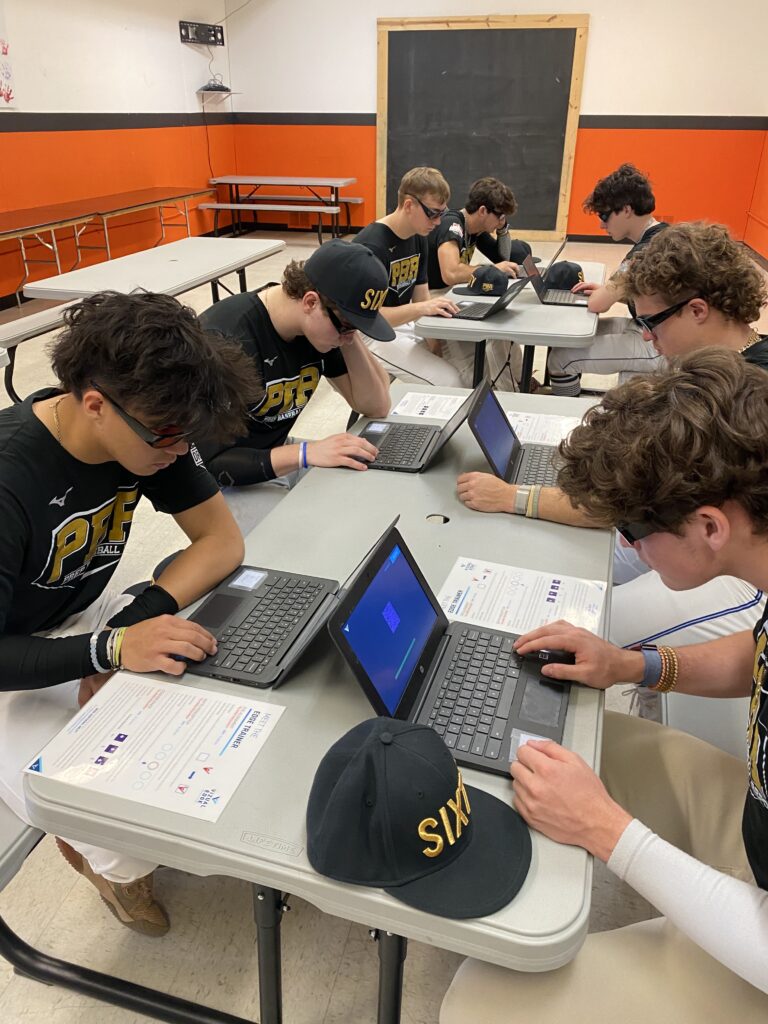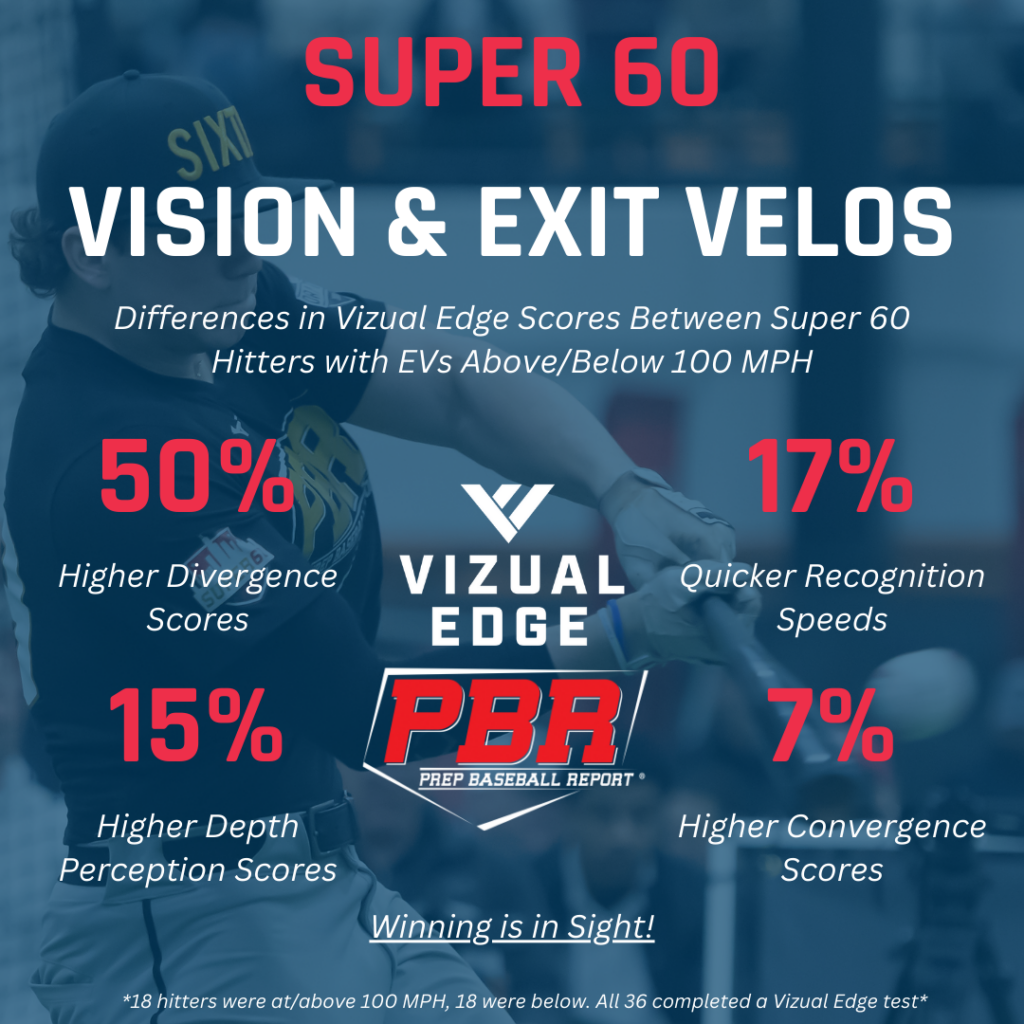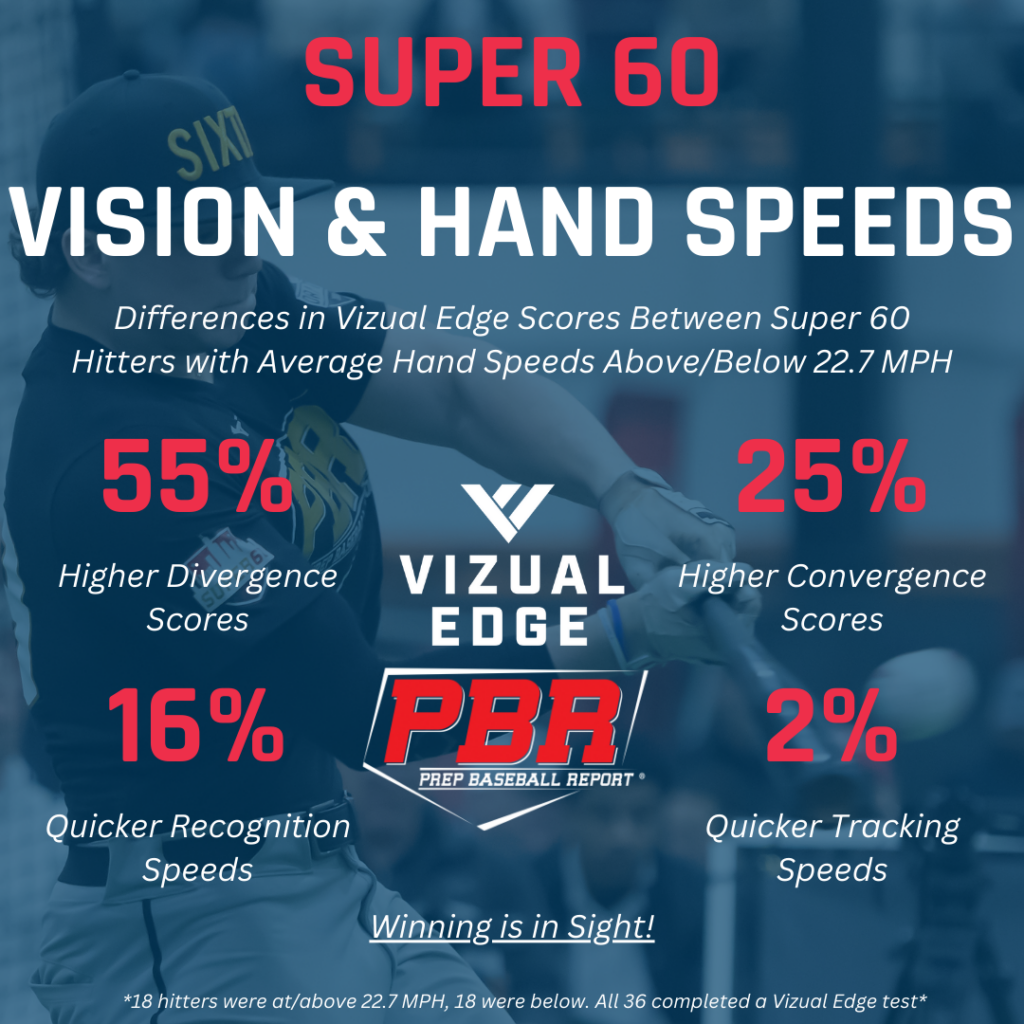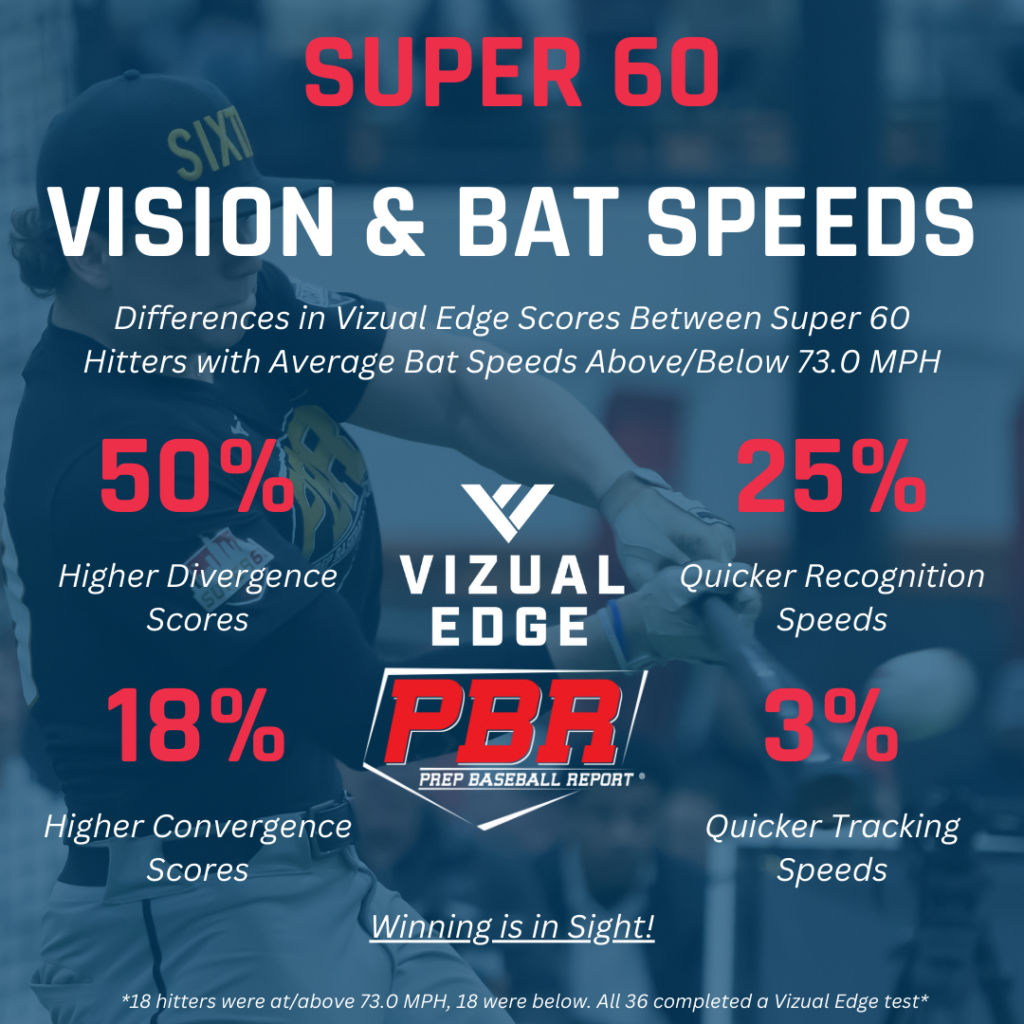Last month marked another tremendous Super 60 Pro Showcase, presented by Prep Baseball Report (PBR), where the top high school and draft-eligible players put their skills on display in Chicago in front of MLB scouts. As the Official Vision Evaluation and Training Technology of PBR, Vizual Edge put all position players through a visual skills baseline assessment, the same test used by MLB organizations.
Vision is commonly thought of as just needing contacts, glasses or having '20/20', but it is often confused with sight. Vision relies on an individual's ability to identify, process and react to what their eyes are seeing. Considering over 80% of sensory information is visual, vision plays an undisputed vital role into the performance of baseball players. There's more to baseball performance than having a great swing or elite power, and vision can be thought of as the unofficial 'sixth tool' in hitting that makes up a complete ball player. As a result, MLB organizations recognize the importance of vision in finding future MLB talent and have relied on Vizual Edge for nearly 20 years to provide them insights. This also led to the introduction of the Vizual Edge baseline test at PBR events and adding our Edge Score to PBR player profiles over the last couple years.

Vision is a trainable skill that can be directly improved from home, using our online Edge Trainer platform, and something that all PBR event attendees can unlock discounts for. Improved Edge Scores lead to improved performance on the field and can ultimately increase an athlete's likelihood of being drafted by an MLB organization. Our research shows that players who generally score higher on our baseline test, tend to be better players and ones who make it further in their baseball careers. A recent study conducted by Vizual Edge looked at the highest level 2010-2015 draftees reached through the 2021 season, and as expected, players who reached the MLB also tested the highest on average on our baseline assessment, the same one PBR players complete.
As we dive deeper into the Vizual Edge metrics from Super 60 players this year, we take a look at the top 5 position-players in four of the key visual skill categories and where each measurement impacts a player’s on-field performance. We also take a look at the visual skill differences in Exit Velocity, Bat Speeds and Hand Speed metrics provided by Trackman and Blast Motion, respectively.
| Rank | Name | Edge Score | State | Commitment | Position |
| 1 | Colin Barczi | 87.57 | IL | Vanderbilt | C |
| 2 | Bradley Link | 87.40 | FL | Michigan | 3B |
| 3 | Cal Fisher | 84.97 | WI | Florida State | SS/2B |
| 4 | Caden Sorrell | 84.41 | TX | Texas A&M | OF |
| 5 | Evan Gustafson | 84.28 | WI | Oregon State | C/3B |
The Edge Score is a comprehensive score out of 100 that takes the core-six visual skills into account, providing athletes, parents, coaches and scouts with a benchmark number for assessing an athlete’s overall visual ability. In general the higher the Edge Score, the higher chance of athletic success.
| Rank | Name | Convergence | State | Commitment | Position |
| 1 | Bradley Link | 71 | FL | Michigan | 3B |
| 2 | Kyle Johnson | 65 | VA | Duke | OF |
| 3 | Cal Fisher | 61 | WI | Florida State | SS/2B |
| 4 | Jaxon Goldberg | 60 | KS | UCF | SS/2B |
| 5 | Caden Sorrell | 54 | TX | Texas A&M | OF |
Arguably the most important visual skill in baseball, Convergence relates to a player's ability to focus on a pitch as it approaches the final 15-20 feet to the plate. Many top hitters in the MLB have elite Convergence scores, another attribute that helps separate them from average hitters.
Convergence has also been a skill that is linked to exit velocity (EV). The maximum Convergence station score on the assessment is 77, and Super 60 position players whose exit velo was at/above 100 MPH had Convergence scores 7% higher than those below that mark.
| Rank | Name | Divergence | State | Commitment | Position |
| 1 | Colin Barczi | 49 | IL | Vanderbilt | C |
| 2 | Chase Krewson | 44 | PA | Duke | OF |
| 3 | Amari Allen | 36 | DC | Chipola | 1B |
| 4 | Cal Sefcik | 34 | IL | Indiana | SS/3B |
| 5 | Hudson Mattox | 27 | MS | Ole Miss | 3B |
Similar to the scoring of Convergence, Divergence is also scored out of 77. Generally a more difficult skill compared to Convergence for baseball players, mainly due to the nature of the sport, Divergence focuses on the ability to locate objects from a distance and often tied to power and homerun rate.
Divergence plays a key role in early pitch and spin detection, as well as locating the ball out of the pitcher's hand.
Convergence and Divergence work in tandem to ensure a hitter can smoothly first identify/locate the ball from the pitcher's hand (Divergence) and be ready and track the ball all the way in as it approaches the plate (Convergence). The use of both of these skills simultaneously is called Alternating Flexibility, another key skill that is trainable with Vizual Edge.
| Rank | Name | Recognition | State | Commitment | Position |
| 1 | Chase Krewson | 0.56s (96%) | PA | Duke | OF |
| 2 | Cal Sefcik | 0.64s (96%) | IL | Indiana | SS/2B |
| 3 | Evan Haeger | 0.65s (89%) | MI | Alabama | OF |
| 4 | Adam Agresti | 0.66s (96%) | NY | St. John's | C/1B |
| 5 | Luke Stevenson | 0.71s (85%) | NC | North Carolina | C |
The Recognition test measures a players ability to view a sequence of three arrows that briefly flash across the screen and then quickly recite and enter the sequence they just viewed. This exercise is scored based on both response time (seconds) and accuracy (%).
At every level, especially with MLB hitters, players who have better Recognition scores generally have better plate discipline, as they are better at first accurately identifying a pitch type, but then also quicker to swing or lay off a pitch.
| Rank | Name | Tracking | State | Commitment | Position |
| 1 | Cal Sefcik | 0.44s (94%) | IL | Indiana | SS/2B |
| 2 | Adam Agresti | 0.45s (94%) | NY | St. John's | C/1B |
| 3 | Trenton Lyons | 0.45s (91%) | TN | Ole Miss | C/SS |
| 4 | Bradley Link | 0.47s (96%) | FL | Michigan | 3B |
| 5 | Jarren Advincula | 0.47s (83%) | CA | Cal | SS/OF |
Tracking is another vital skill in baseball for hitting AND fielding. The Tracking exercise is scored based on response time and accuracy (just like the Recognition test) and tests a player's saccadic eye movements to locate a quick moving arrow and enter the correct response. Players with better Tracking skills generally have a better ability to see a ball approach the plate, as well as react quick enough to identify the speed and distance of the ball as soon as it leaves an opponent's bat.
Another important type of tracking skill is called smooth pursuits, which is not featured in our baseline test but is included in our online training platform.
"How do Vizual Edge scores translate to hitting performance?" A question we are often asked at Vizual Edge, and the answer is relatively simple: better hitters tend to have better visual skills. This year, we compared Super 60 hitters' max exit velocity above and below 100 MPH (18 players in each group) and their Vizual Edge test scores. Players with EVs above 100 MPH had 50% better Divergence scores, providing further evidence to an earlier point about Divergence correlating with power. Exit velocities were captured by Trackman, a 3D Doppler radar system that precisely measures the location, trajectory, and spin rate of hit and pitched baseballs.

Hitting a baseball is an incredibly difficult task, and the human brain can only process information so quickly. A 2017 study from The Seattle Times found that "a 100-mph fastball takes roughly 375-400 milliseconds to reach the plate, and for reference, the blink of an eye takes 300-400 milliseconds."

Visual processing speed is a focal point here at Vizual Edge, and Blast Motion is an industry-leader with their swing capture analyzer. Recognition and Tracking are two important exercises on the Vizual Edge test that relate to a player's visual processing speed, and are also trainable skills. This year, we looked at two main Blast Motion metrics, Hand Speed and Bat Speed.
Hand Speed is the observed speed as measured on the handle of the bat (measured six inches from the knob of the bat) and occurs prior to the moment of impact, while bat speed is the observed speed of the sweet spot of the bat at impact1. Players that are able to visually process an incoming pitch quicker are faster with their hands and have overall faster bat speeds.
Super 60 players with Hand Speeds above 22.7 MPH were 0.20s quicker at the Recognition portion of the baseline test. Similarly, players with Bat Speeds above 73.0 (within the MLB range) were 0.32s quicker at Recognition. In both groups, players were also at least 50% better at Divergence, which allows them to pick up the ball earlier to be more prepared as it approaches the plate.


At the end of the day, vision alone isn't going to make you become an MLB player, but it does play a critical role in performance. There are many variables that make the entire profile of an athlete, and Vizual Edge believes visual skills are one of them. Regardless of what your scores are now, visual skills are trainable and something you can do right at home!
Vizual Edge trains each of these visual skills in a simple, online platform called the Edge Trainer. It is designed to improve each of these skills in just 15 minutes, 3x a week, right from home and all on your own computer/iPad. Vision training is the easiest way to improve performance, and knowing how important vision is in baseball, what are you waiting for?
To learn more about the Vizual Edge online vision training/evaluation program and unlock exclusive PBR discounts, please visit VizualEdge.com/PBR.